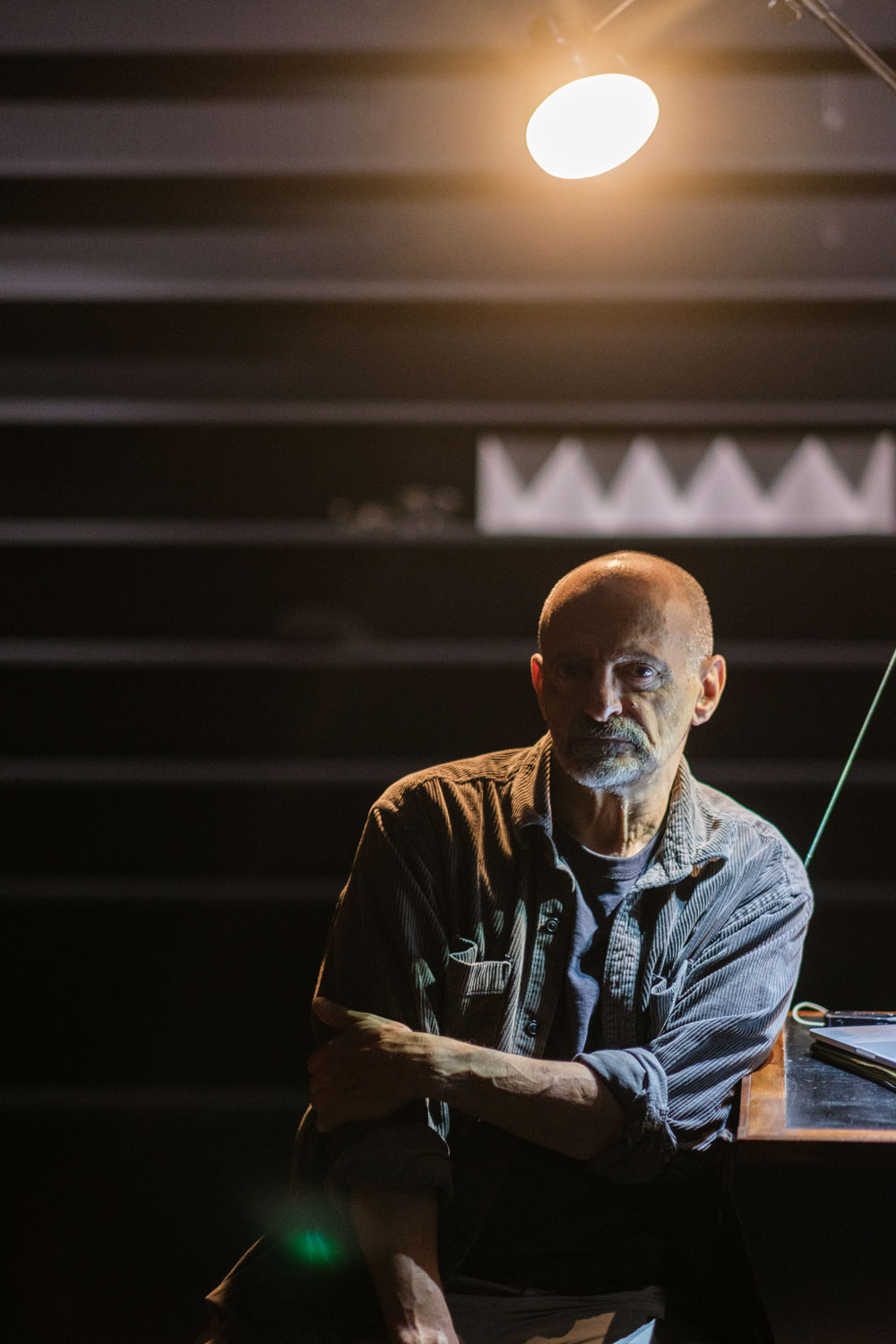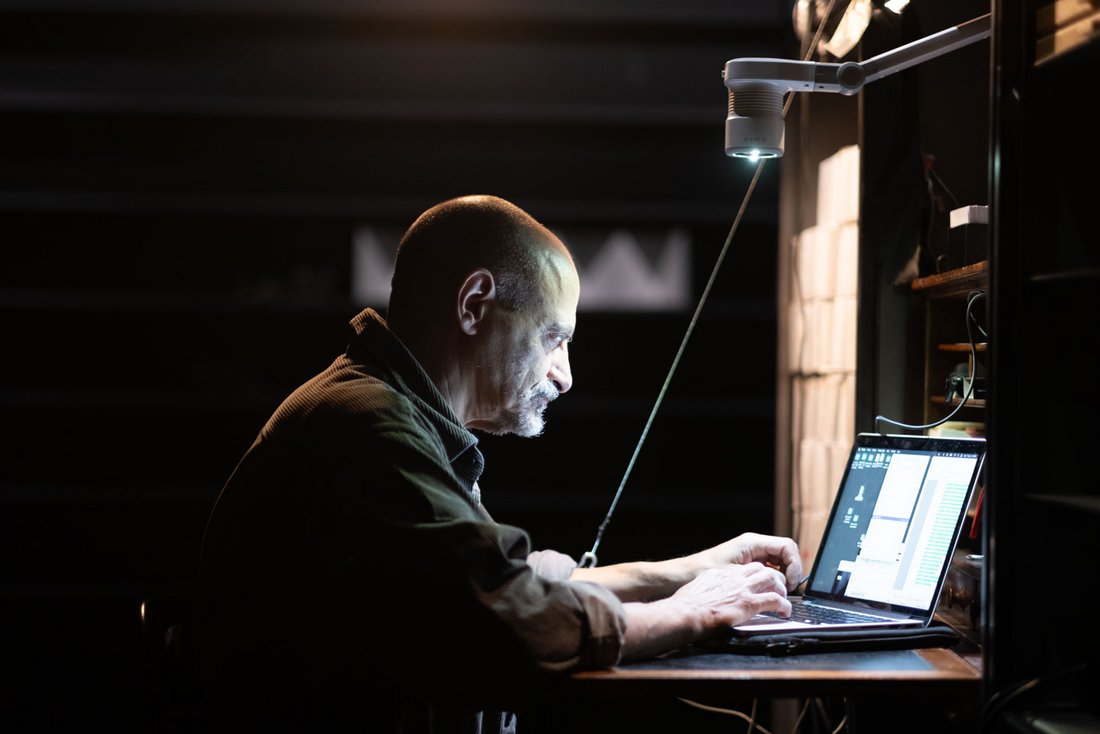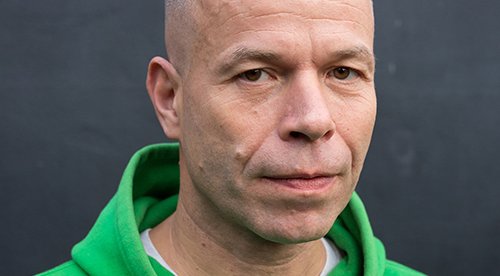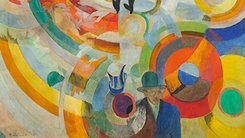
Antoine d'Agata: "I can only create in a state of permanent fragility."
No invitation is required to meet Antoine d'Agata, born in 1961 in Marseille, a prominent figure of the Magnum agency since 2004 and one of the most intriguing contemporary photographers of his generation. Simply visit level 4 of the Centre Pompidou, in room 21 bis of the Museum, where the photographer has set up his personal effects for a hundred-day residency, punctuated by meetings with intellectuals. It's also an opportunity to discover the artist's working process.
In the darkness of the room, on the right, there's a pile of boxes and a few suitcases containing most, if not all, of his sparse possessions—many of which are contact sheets. Along the black walls, shelves are gradually being filled, meant to house his 256 workbooks. At the center of the space, there's a kind of drawer-filled cube, some computer equipment, and a lamp. Alongside the laptop screen, this lamp is the sole light source, casting the space in chiaroscuro and highlighting the deeply etched features of the man absorbed in his ambitious task: organizing, archiving, and sorting through thousands of images. Silence prevails, making one almost forget his presence, until a visitor, driven by curiosity, jumps when they see him stir.
I needed to close a cycle of twenty-five or thirty years of photography. To build a physical, concrete archive.
Antoine d'Agata
Antoine d'Agata did not want to exhibit once more. “To display yet another selection of my images, no thank you. I needed to close a cycle of twenty-five or thirty years of photography. To build a physical, concrete archive.” For someone grappling with physical and mental exhaustion, as conveyed by his sometimes fragmented speech, it’s an opportunity to pause. In an attempt to distance himself with the incessant need to work and his studio-world, finding solace in the darkness of Room 21 is a kind of liberation for both his body and his mind. “The only rule I’ve set for myself is not to think about what I’ll do next. But also, to regain lightness, a freedom of movement.”
According to d'Agata, his life is divided into two equal periods. During the first, of which he chose to keep no tangible record “for ideological reasons,” he moved through the margins of a world he was trying to decipher. His wanderings led him to places like Mexico and the United States, where he explored marginality and underground environments. In 1990, while living in New York, he enrolled at the International Center of Photography, where Larry Clark and Nan Goldin—both crucial influences on his approach—taught him. This marked the start of his second phase.
His camera becomes an extension of his body, a tool to decipher the deepest corners of the human soul.
Since then, d'Agata has used photography in the most radical way possible. His goal? “To live up to my convictions and what inspires me. That takes me to the darkest places, the shadowy zones. I share my experiences; I offer them for others to see.” It is in these cracks that the photographer (an insomniac since adolescence) has his most intense, absolute experiences, even if it costs him dearly. A world of violence, desire, addiction... inhabited by outcasts, oppressed, prostitutes, and drug addicts, whose voices he carries. His camera becomes an extension of his body, a tool to decipher the deepest corners of the human soul. His images, often blurry, grainy, and oversaturated, reflect his subjective, emotional vision, resulting in a raw, uncompromising truth.
My relationships with the images go far beyond those of a photographer with a model. All of these photographs are based on emotional, even romantic relationships.
Antoine d'Agata
It's not uncommon for d'Agata to relinquish his role as photographer, handing over his camera to the people with whom he interacts. He becomes part of the image, disrupting the very concept of documentary photography and adding a performative dimension to his work—the distance between the lens and lived experience shrinks to nothing. He immerses himself in the scenes he captures. “The night is a violence I know, an extreme world. My relationships with the images go far beyond those of a photographer with a model. All of these photographs are based on emotional, even romantic relationships.”
I can only create in a state of permanent fragility. I seek images that elude me, I’m actually trying to lose control.
Antoine d'Agata
He claims a position of vulnerability, enabled by sex and drugs, a borderline state that fuels his creative process. “I can only create in a state of permanent fragility. I seek images that elude me, I’m actually trying to lose control,” he admits. This also applies on a mechanical and technical level; d'Agata isn’t one to work exclusively with a single camera model. On the contrary, the more foreign the tool, the more it opens the door to risks, chance, and accidents: “I don’t want to lock myself into a particular style or language.” For him, the essential lies elsewhere—in the intensity, in the truth of the moment.
By day, d'Agata confronts another kind of violence—social and political, dominated by death. After the Bataclan attacks in November 2015, he used a thermal camera, as he had done in Hiroshima. He photographed the interiors of places of worship (churches, mosques, synagogues), stripping believers of the specificity of their rites, reducing them to mere silhouettes. Later, he documented the pandemic from the inside, notably in two hospitals in Bordeaux and Nancy. Over the course of two months of lockdown, he amassed 13,000 photos, half taken on the streets, the other half in hospitals. “The camera abstracted all the details—the faces, the blood, the filth, everything we don’t necessarily want to see. What remained were the gestures of care, of proximity. Gradually, the hospital became a place I needed.”
By day, d'Agata confronts another kind of violence—social and political, dominated by death.
More recently, d’Agata was in Ukraine with the writer Jonathan Littell, another globetrotter. Their plan? To photograph Babi Yar, the site of the largest mass shooting of the Ukrainian Holocaust, where all memory has been erased. To photograph erasure, in essence. It didn’t take much more to convince d’Agata to join the project. When the war broke out, the two naturally adapted, certain that history was being written as the bell tolled for a peaceful Europe. Another book has since emerged, filled with haunted images: portraits, ruins, pits, faces of Russian soldiers… their raw truth testifying once again to the intimate stance the photographer adopts.
I’m obsessed with boxes. I think they help channel the chaos within me. I need these structures.
Antoine d'Agata
In contrast to the intensity and urgency that have governed his life thus far, room 21 bis is orderly; there are shelves, everything is neatly arranged. “I’m obsessed with boxes,” confesses Antoine d’Agata. “I think they help channel the chaos within me. I need these structures.” Could structure be an antidote to physical and mental disarray? The Centre Pompidou provides an initial geometric, angular envelope, followed by its straight-edged walls and right angles within. All these lines act like a photographic grid. “I’ve often photographed deformed bodies, sometimes face to face, or confined within structures, landscapes, grids of images. The frame allows me to delve deeper into the disorder.” No doubt the artist will use these hundred days to once again invent new forms of visual storytelling. ◼
Related articles
In the calendar
Photographer Antoine d'Agata at work during his hundred-day residency at the Centre Pompidou
Photo © Pierre Malherbet




